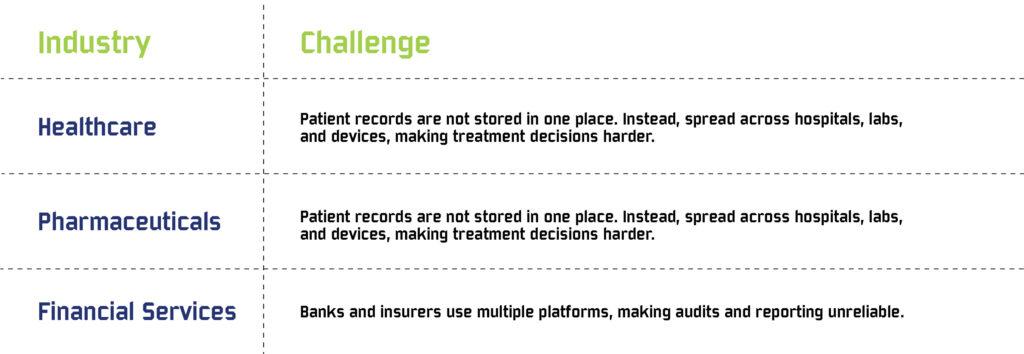
Is Your Data a Mess? How to Build a Single Source of Truth
Data chaos is more than just an operational headache. We’ve seen firsthand how scattered, incompatible data slows teams, leads to inconsistent reports, and increases errors. The stakes are high in heavily regulated industries like finance, healthcare, and pharma. Fragmented data becomes a compliance risk and financial burden.
But there’s a way out! Organizations can control, streamline decisions, and build trust in their data by applying a single source of truth. Let’s explore how you can transform messy, siloed information into a strategic asset with Xpediant’s MarTech experts.
The Data Fragmentation Dilemma in Regulated Industries
Data fragmentation is when important information is spread across multiple systems, formats, and teams. No single view exists; instead, you have siloed databases, duplicate records, and outdated files scattered everywhere.
For industries with strict rules, this creates serious challenges:

In these industries, small data errors can lead to legal violations, audit failures, medical mistakes, or lost business. Fixing the data is a clear business priority.
Featuring The Solution “SSOT”
The solution to the siloed data is through a Single Source of Truth (SSOT). It is a central, trusted system where all important business data is stored and accessed. Instead of conflicting reports and scattered databases, companies rely on one accurate and up-to-date source. Some of the benefits are:
- Better Decisions: Teams spend less time verifying numbers and more time taking action
- Easier Compliance: A single data system simplifies audits and ensures records meet regulations (GDPR, HIPAA, etc.)
- Increased Productivity: No more searching across multiple systems—data is always in one place
- Stronger Collaboration: With shared data, teams work together without confusion
Barriers to Achieving a Single Source of Truth

If SSOT is so great, why do so many companies still struggle with messy data? Implementing a single source of truth is challenging due to several common barriers:
1. Disconnected Systems: Many organizations work with numerous applications and databases. This makes it difficult to collect all the information into a unified system.
2. Data Quality Issues: Adding data from various sources can cause duplicate records. Without clean data, these issues can question the reliability of an SSOT.
3. Internal Resistance: Departments may hesitate to share data or alter established workflows.
4. Security & Compliance Risks: Regulations like HIPAA require strict controls, sometimes forcing data silos instead of eliminating them.
5. Lack of Resources: SSOT requires investment in tools and expertise. Without a clear plan, it can feel overwhelming.
SSOT isn’t just a technology fix– it’s a shift in how businesses handle data. The good news? With the right approach, these challenges can be tackled. Next, we’ll talk about the right approach.
A Structured Approach to Building Your Single Source of Truth (SSOT)
Achieving a Single Source of Truth (SSOT) is a strategic effort—one that requires the right technology, governance, and collaboration. Here’s a streamlined approach from Xpediant’s MarTech experts to guide your organization from data chaos to clarity:
Assess and Audit Your Data
Begin with a comprehensive audit of your data sources, including CRMs, databases, and spreadsheets. Identify problems and siloed teams to discover integration opportunities. Key questions to ask are:
- Where is important data stored?
- Are multiple versions of the same data being maintained?
- How often do you face conflicting information?
Define Clear Goals and Success Metrics
We recommend defining what SSOT means for your business. Whether it’s improving reporting accuracy, improving compliance, achieving a 360° customer view, or specific goals (e.g., “reduce data reconciliation time by 50%”). Focus on which data domain to unify first,like customer records or digital content.
Choose the Right Integration Platform
Select tools that ensure smooth data integration, quality management, and compliance. Consider platforms with API connectivity, deduplication, and proper synchronization. Modern solutions like Xpediant Digital’s XpConnect® can accelerate deployment.
Establish Data Governance & Standards
SSOT is a data management philosophy. Defining ownership, applying standards (naming conventions, validation rules), and scheduling audits are critical for maintaining data integrity. Implement access controls to ensure security and compliance.
Build Cross-Department Collaboration
Break down silos by involving key stakeholders across departments. Make them aware of the benefits—faster decision-making for sales and easier audits for compliance teams.
Implement in Phases & Monitor Impact
Avoid a “big bang” rollout. Start with high-value, low-risk areas, track progress with key metrics like data accuracy, user adoption, and time saved on reporting. Treat SSOT as an evolving system—gather user feedback and refine it continuously.
Best Practices to Maintain SSOT
- Prioritize small but impactful integrations to demonstrate success and build momentum
- Appoint data stewards to monitor quality, adapt standards, and address issues proactively
- Provide clear guidelines to prevent workarounds that could reintroduce data silos
- Regular reviews help align SSOT with business goals and regulatory needs
- Reassess your SSOT strategy annually to incorporate new technologies, regulations, and business needs
Following these structured steps and best practices, your Single Source of Truth will become a reliable foundation for practical decision-making—empowering your business with clarity, consistency, and productivity.
Struggling with Data Chaos?
A well-structured Single Source of Truth transforms data from a liability into a strategic asset. By combining clear goals, the right tools, and cross-team collaboration, your organization can gain a competitive advantage and ensure compliance.
See how XpConnect® can simplify compliance and boost productivity. Book a personalized demo today!

Attending Adobe Summit (March 18–20 in Las Vegas)? Come meet us in person to see how XpConnect® can revolutionize your content and data strategy!




